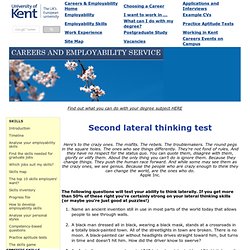

Teenagers: Lateral thinking. Lateral thinking Archives - ESL Kids Games : ESL Kids Games. Enigma Enigma is a quick and simple ESL game you can put together in no time.

It’s a great ESL game for teens and adults of all levels but can be easily adapted for younger learners. It’s a great activity to practice question forming and practising vocabulary from previous lessons etc. It’s also an enjoyable way of creating fun and unusual stories and could even be used as creative writing starters. Activity Time: 10 minutes +Materials required: White board and marker.Number of students: 2 +Skills practiced: Listening, speaking, question forming and Vocabulary.Level: All levels. Four pictures one word ESL Game. RecPuzzlesArchive - Lateral Solution. Paul Sloane's list of Classic Lateral Thinking Puzzles Lateral thinking puzzles are often strange situations which require an explanation.

They are solved through a dialogue between the quizmaster who sets the puzzle and the solver or solvers who try to figure out the answer. The puzzles as stated generally do not contain sufficient information for the solver to uncover the solution. So a key part of the process is the asking of questions. The questions can receive one of only three possible answers - yes, no or irrelevant.
When one line of enquiry reaches an end then another approach is needed, often from a completely new direction. Some people find it frustrating that for any puzzle it is possible to construct various answers which fit the initial statement of the puzzle. This kind of puzzle teaches you to check your assumptions about any situation.
The Top Ten Lateral Thinking Puzzles. Lateral thinking puzzles are strange situations in which you are given a little information and then have to find the explanation.

They are solved through a dialogue between the quizmaster who sets the puzzle and the solver or solvers who try to figure out the answer. The puzzles as stated generally do not contain sufficient information for the solver to uncover the solution. So a key part of the process is the asking of questions. The questions can receive one of only three possible answers – yes, no or irrelevant. When one line of enquiry reaches an end then another approach is needed, often from a completely new direction. Some people find it frustrating that for any puzzle it is possible to construct various answers which fit the initial statement of the puzzle.
This kind of puzzle teaches you to check your assumptions about any situation. This list contains some of the most renowned and representative lateral thinking puzzles: Lateral Thinking. More Lateral Thinking Puzzles. Here's to the crazy ones.

The misfits. The rebels. The troublemakers. The round pegs in the square holes. The ones who see things differently. The following questions will test your ability to think laterally. Name an ancient invention still in use in most parts of the world today that allows people to see through walls. How can you throw a ball as hard as you can, and make it stop and return to you, without hitting anything and with nothing attached to it? Score Check your answers below. For more examples of lateral thinking in jobhunting see our Creative Careers Search page Also see our First lateral thinking test and our Riddles test. Realistic Lateral Thinking Puzzles. Lateral Thinking Puzzles, unlike most puzzles, are inexact.

In a sense, they are a hybrid between puzzles and storytelling. In each puzzle, some clues to a scenario are given, but the clues don't tell the full story. Your job is to fill in the details and complete the story. Obviously, there is usually more than one answer to any given puzzle, but, in general, only one solution is truly satisfying. You can try solving these puzzles on your own -- that's certainly a legitimate way to go about this -- but usually you can have more fun if you involve other people. Warning: For some reason, these puzzles have a tendency to be rather morbid.
The scenarios given on this page are realistic, if unlikely. Lateral Thinking Puzzles - Preconceptions. Lateral thinking puzzles that challenge your preconceptions. 1.

You are driving down the road in your car on a wild, stormy night, when you pass by a bus stop and you see three people waiting for the bus: 1. An old lady who looks as if she is about to die. 2. An old friend who once saved your life. 3. Knowing that there can only be one passenger in your car, whom would you choose? Hint: You can make everyone happy. Solution: The old lady of course! 2. Hint: The police only know two things, that the criminal's name is John and that he is in a particular house. Cockroaches and Ladybugs: Lateral Thinking Stories for the ESL Class. What is lateral thinking?

In 1973 Edward De Bono developed the term “Lateral Thinking”. Lateral thinking involves looking at a situation or a problem from a unique or unexpected point of view, avoiding the linear and step by step approach of a normal problem solving. He proposed instead a more creative answer from taking a step “sideways” to re-examine a problem from an entirely different and more creative viewpoint. De Bono suggests that lateral thinking is necessary for coming up with solutions that aren’t so straightforward.